Nixeus NX-VUE27 27" Monitor: High Resolution for the Masses
by Chris Heinonen on September 20, 2012 6:10 PM ESTDisplay Uniformity
With the primary measurements out of the way, we now turn to testing display uniformity. It's easier to get good results at the center of a display, while extending the results to the corners and edges requires a lot more effort. Let's see how uniform the Nixeus is.
When the center of the ANSI grid is set to 200 nits of brightness, the surrounding blocks are all close, though it is better at the lower section of the screen with an average of 95% of the center brightness. Once you move to the outside of the monitor the readings drop by at least 7%, falling all the way to a 17% drop off in one corner. The overall average is 89% of the center brightness, or 181 nits. This is actually pretty normal for monitors, particularly larger models, and it's only very expensive professional displays like the NEC display we reviewed that tend to do better.
Black uniformity does not mirror the white uniformity in this case, which could be due to the updated testing method, panel and backlighting uniformity, or a combination of both. The deepest blacks we get are in the corner with 0.353 nits in the upper-left, which also happens to be the darkest spot in the white uniformity testing. The brightest spot, no surprise, is in the center of the screen that measures 0.420 nits. The average black level winds up at 0.390 nits for all measurements. This is okay for black levels but certainly not outstanding.
Our contrast is more uniform across the panel, as areas with high white levels typically have high black levels as well, an indication of the backlight level in that section of the screen. The exception seems to be the upper-right section of the screen where we have higher black levels and lower white levels. I thought these were suspect and measured them multiple times, but always found the same results. The average contrast ratio for the center of the panel is 473:1 and for the outside it's 461:1, so that is fairly uniform for the whole display.
Looking at the dE uniformity of the Nixeus, it tracks really well across the whole screen. The main errors occur in the grayscale, which is what we typically see, but otherwise the numbers are almost spot on across the monitor. We do see a rise on the left side of the monitor relative to the rest of the display, likely from the lighting uniformity issues, but there aren't any extreme variances.
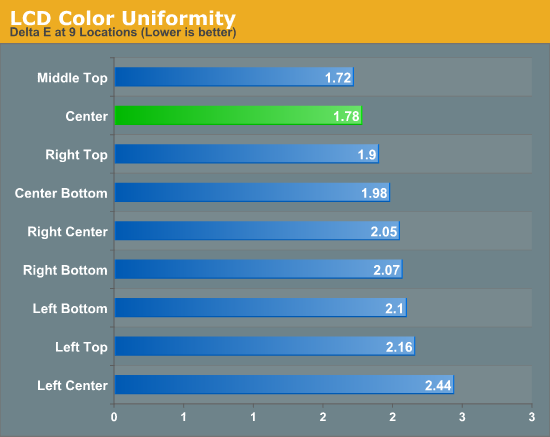
In summary, the uniformity of the Nixeus NX-VUE27 is decent and is similar to what we have seen from other non-professional 27” flat panels. The contrast ratio leaves a good bit to be desired, as the black floor is not what it should be in this display. I could enable the Dynamic Contrast mode to help that, but since it has only one setting and is very noticeable (not in a good way), I wasn’t inclined to enable it.


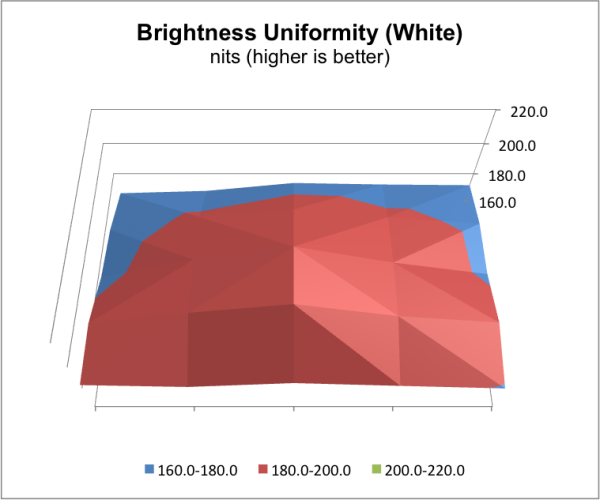
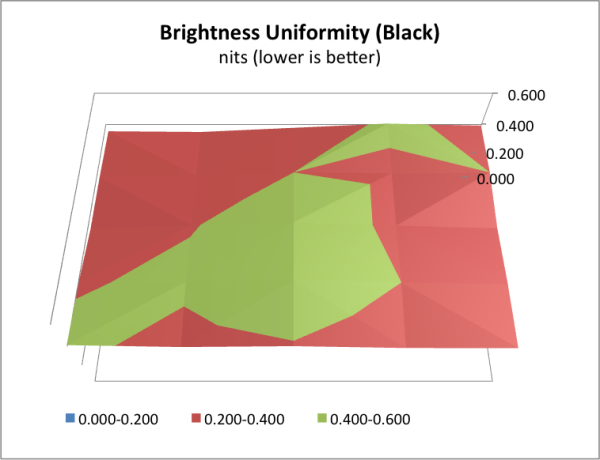
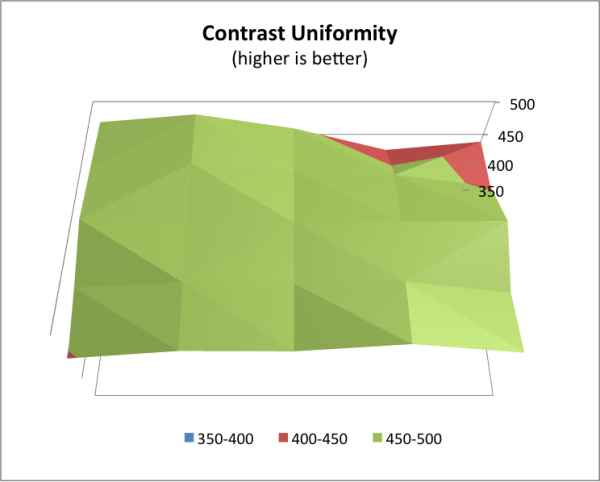
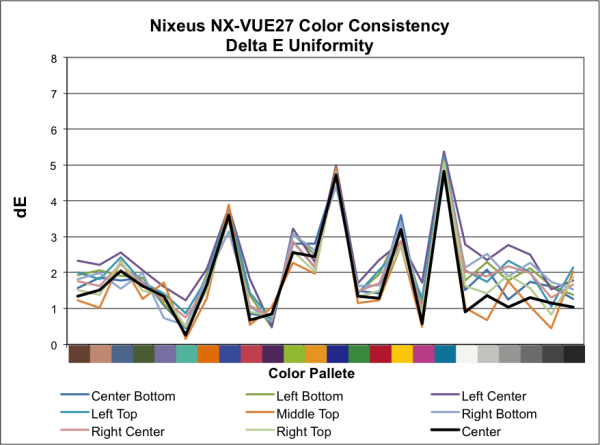
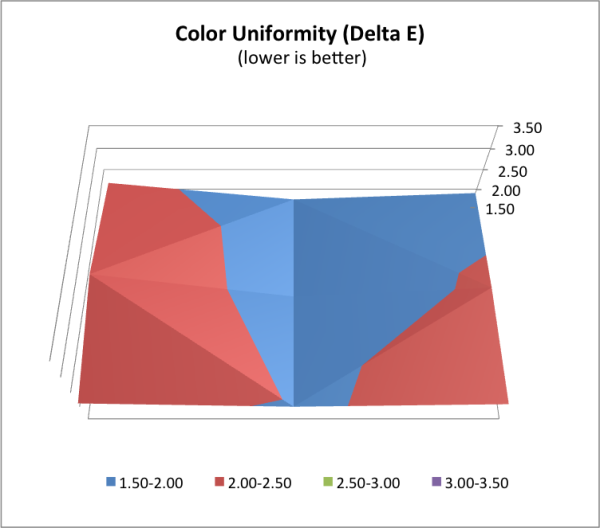








66 Comments
View All Comments
Karman - Thursday, September 20, 2012 - link
"I wish they would have used different screws for attaching the support column to the display than they did for the base, to make it easier to differentiate."If the screws are all the same (as the text implies) there is nothing to differentiate. Selecting the correct screw couldn't get any easier!
cheinonen - Friday, September 21, 2012 - link
The screws are different, but only slightly different, so it's easy to get the two confused if you were to mix up the bags, or disassemble it. For connecting it to the display, I'd prefer something like a thumbscrew that you can easily install, and then use a screwdriver for the final tightening like the Antec P182 case has for keeping the panels on. Just something that looks more distinct.Bateluer - Thursday, September 20, 2012 - link
Ended up being 290 each with shipping. With the warranty/support questions, I picked up the 3yr SquareTrade Warranty for each as well. They are definitely cheap, the stands wobble, the two displays aren't level with each other on the unadjustable stand, and I had to adjust the calibration manually. But all in all, they have no dead pixels and no back light bleed, so I'm very happy with the purchase.The major downside is how poorly some of my games run at 5120x1440 on a Radeon 6950. :( Damn EyeFinity.
Sabresiberian - Friday, September 21, 2012 - link
Well at that resolution you really need more than one video card, and as strong as you can afford. It's also possible to reach 2GB of memory use in some games. The PCIe 2 interface can effect your results as well, though again, I wouldn't expect it to make a huge difference for you.You might be able to use the cheaper monitor, but there is no cheaper video card solution to match that kind of price range. Really, switching to one 7970 would make a big difference for you, and might give you good enough performance that you are satisfied with your gaming experience.
;)
hechacker1 - Thursday, September 20, 2012 - link
For that kind of money, I'd just go get the certified 120Hz version from Korea. Sure the warranty and build quality won't be as good, but they do guarantee their best A- panels along with 120Hz and not "too many" dead pixels for that price.Doh! - Thursday, September 20, 2012 - link
Be aware that some of these inexpensive "Korean" panels are actually Chinese panels (made in China by Chinese OEM manufacturers and supplied to Samsung/LG and sold as Samsung/LG panels).In Korea, the tech-savvy buyers always investigate the origin of the panel as the quality of the panel varies significantly between the Samsung/LG-manufactured ones from the OEM-supplied panels made in China.
Besides the panel (or sometimes including the panel as noted above), every other components such as the stand, case are made in China by the way.
It's a shame that better manufacturers using the genuine Samsung/LG panels and high-quality workmanship are not yet available outside of Korea as the price is not much more than these "knockoffs" monitors.
trynberg - Thursday, September 20, 2012 - link
http://accessories.us.dell.com/sna/productdetail.a...jackstar7 - Thursday, September 20, 2012 - link
I wouldn't call that a great deal though as it is only:1920 x 1080 at 60 Hz
trynberg - Thursday, September 20, 2012 - link
Fair enough.Roland00Address - Thursday, September 20, 2012 - link
Which is not the same as 2560x1440 panels that Chris is referencing.